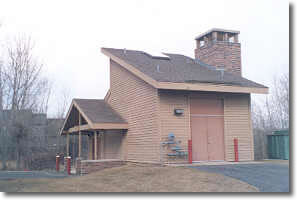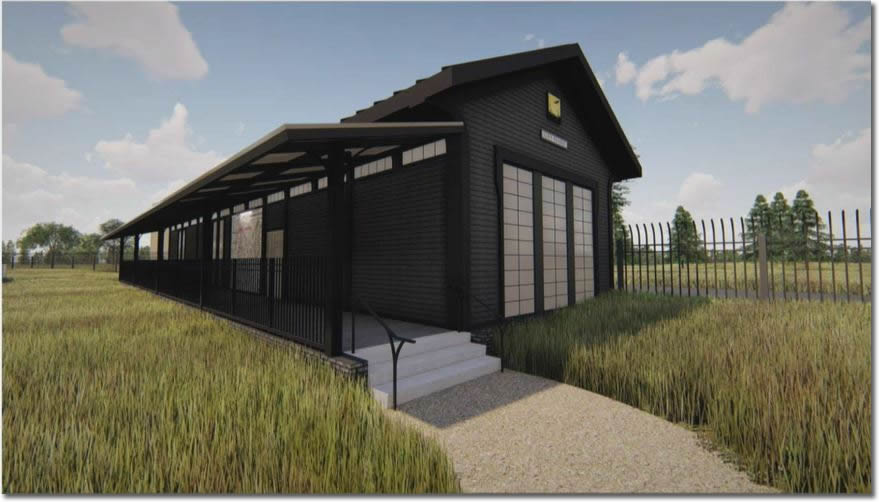Drinking Water Protection
- Drinking Water Protection Home
- About Us
- A-Z Index of Contaminants in Water
- Community Public Water Supply
- Drinking Water Grants and Loans
- Drinking Water Institute
- Drinking Water in Schools and Child Cares
- Drinking Water Revolving Fund
- Laws and Rules
- Noncommunity Public Water Supply
- Source Water Protection
- Water Operator and Certification Training
- Drinking Water Protection Contacts
Related Topics
- Annual Reports
- Drinking Water Risk Communication Toolkit
- Drinking Water Protection External Resources
- Fact Sheets
- Forms
- Invisible Heroes Videos: Minnesota's Drinking Water Providers
- Noncom Notes Newsletter
- Sample Collection Procedures (videos, pictures, written instructions)
- Waterline Newsletter
Related Sites
- 10 States Standards
- Clean Water Fund
- Health Risk Assessment – Guidance Values and Standards for Water
- Minnesota Well Index
- Water and Health
- Wells and Borings
Environmental Health Division
Eden Prairie Grows with Its Water System
From the Summer 2012 Waterline
Quarterly Newsletter of the Minnesota Department of Health Public Water Supply Unit, Waterline
A complete list of feature stories can be found on the Waterline webpage.
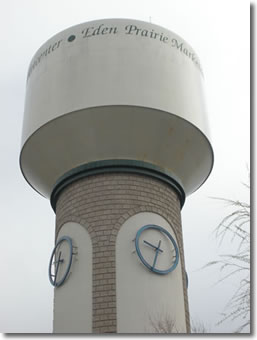
Eden Prairie has grown from a small farming village to a thriving regional center 12 miles southwest of Minneapolis. Its 36 square miles feature hills, lakes and wetlands, trails, prairie, and forests with the Minnesota River as its southern boundary. Eden Prairie Shopping Center, Flying Cloud Airport, the headquarters of the Minnesota Vikings, Hennepin County Technical College, the Southwest transit hub, and a growing number of high-tech businesses are in the city, which has become the place to live for many athletes from the state’s major league sports teams.
From 2,000 residents in 1960 to more than 60,000 a half-century later, Eden Prairie can trace its success to many factors. One is the public water system, which began in the early 1970s. A pair of wells first served the citizens as the city looked at options for a treatment plant. The city council had a long-term vision in mind, looking to meet residential and commercial needs for the coming decades, and decided to have lime softening as part of the process. Its neighbor to the east, Bloomington, was softening its water, and the Eden Prairie council wanted to be competitive and flexible with its water supply.
Rick Wahlen, who has been the manager of utility operations for the city since 2006, says he gets questions from other cities on how to be attractive to industry with their water systems. Often, businesses considering a property site in Eden Prairie ask about the water supply, wanting to make sure their water needs will be met if they move to the city. “Much of the development [in Eden Prairie] goes back to the council looking at a good water treatment plant.”
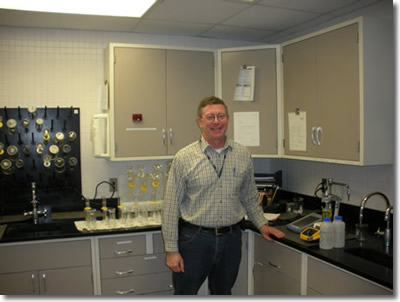 |
| Above: Rick Wahlen in the water treatment plant’s laboratory. Below: A basin added as part of the 1998 expansion. |
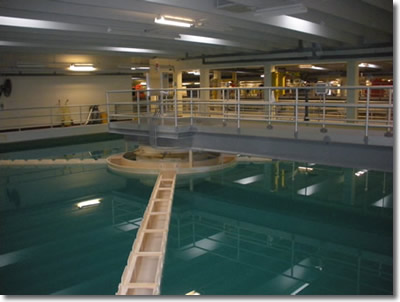 |
The split-treatment facility, which opened in 1974, had a capacity of 4 million gallons a day (MGD) with two-stage clarification: lime softening and coagulation with ferric sulfate (now ferric chloride) followed by dual media filtration. The treatment plant has been expanded three times—in 1978, 1988, and 1998—to bring its capacity to 28 MGD. The utility averages about 6 MGD in the winter and up to 23 MGD in the summer.
At the time of the first treatment plant expansion, in 1978, the city added another well and has been installing wells periodically since 1982. Fifteen wells, approximately 400 feet deep and each with a pumping capacity of 1 to 2 MGD, extend into the Prairie du Chien and Jordan aquifers. The hardness of the raw water is around 320 parts per million (ppm) and is 90 ppm after treatment.
The original treatment plant had built-in storage of approximately 1 million gallons. In 1981 a 2 million gallon tank on a hill at the north end of town, off Baker Road, was added and followed by two towers: the 1-million-gallon Hidden Ponds tower in 1988 and the 2-million-gallon Market Center tower in 1996. The Market Center tower is notable for its attractive design, which includes 18-foot-diameter clocks on all sides and an arch design with a masonry pattern on its concrete pedestal. The tower is also famous for having caught on fire three times, once during construction when the curing concrete generated enough heat to set fire to the foam forms, and twice because of the neon lighting within the clock melting plastic and creating flames.
The three above-ground tanks surround the city in such a manner to aid firefighting. Dale Folen, then a project manager at the Minnetonka firm of Rieke Carroll Muller Associates, Inc. when the tower was built, explained, “The ability to fight a fire from multiple directions optimizes the watermain sizing. If you can cause water to flow from two different directions in fighting a fire, you cut the velocity in half and double the available water going to it.”
In addition to its tank and towers, Eden Prairie has three underground tanks on the north side of the treatment plant for another 3.5 million gallons of storage.
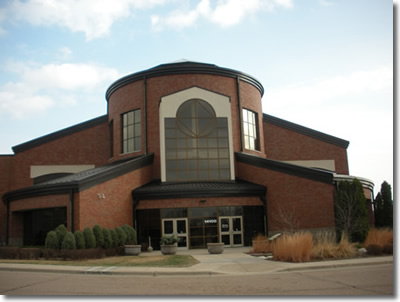 |
| Above: The Eden Prairie water treatment plant, originally built in 1974, was last expanded in 1998. Below: Bob Peterson explains the utility’s SCADA system, which, along with the utility’s process control and chemical feed systems, is undergoing major upgrades. In May 2012 the city learned it had won the “Mayor’s Challenge for Water Conservation” for the Midwest Region for cities in the 30,001 to 100,000 population category. |
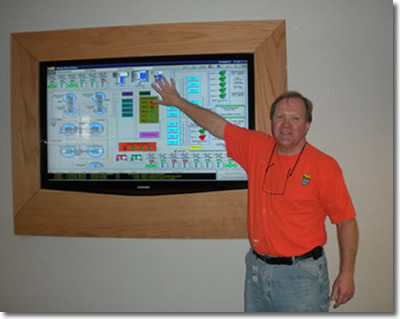 |
The 1998 plant expansion added an environmental education center. The utility brings in students and others to raise awareness about water. The center has also hosted the Drinking Water Institute, an annual three-day seminar for science teachers to learn about ways to add drinking water to their curriculum, and is the metro home for the Water Environment Technologies course conducted by St. Cloud Community and Technical College.
Wahlen says he knows the importance of communication and education about water. Responsible use of water by residents helps to keep their summer peaks at manageable levels. The city had a decline in water consumption the last two years, a result of conservation although Wahlen says it may have been affected by a pair of wet summers and that they’ll get a better idea of how people steward their water use as they come into a dry spring and summer.
In 2011 Eden Prairie went from a two-tiered to a five-tiered residential rate structure. “We kept the rates reasonable for reasonable users,” said Wahlen, with the lowest rate being $1.85 per thousand gallons and the highest at $4.35 per thousand gallons. Wahlen said most of their commercial customers use a more consistent amount of water year-round although those who need irrigation as part of their business have a separate irrigation meter billed at $2.85 per thousand gallons at the lowest tier, up to a maximum of $4.85 per thousand gallons for use above 26,000 gallons per month.
The 1998 expansion also focused on the grounds as a public example of water-conserving landscapes, providing a pleasant appearance and using flora that needs little water.
A pleasing appearance is part of the other utility facilities away from the plant, conforming with the city’s “brick or better” standard for commercial property. Well 7 is housed in a split-level structure designed to blend in with adjacent houses, and another wellhouse was built with two-tone gray rusticated stone to match an office building behind it. The wellhouse by the entrance to City Hall includes an electric signboard with messages about city business and community events.
Although Eden Prairie is built out to its limits on all sides, the city anticipates some redevelopment as well as potential for more multi-family dwellings, especially with the coming of the Southwest Light Rail Transit line. The comprehensive plan estimates a population of 77,000 by 2030.
Wahlen said they’re in a position to meet the demand and ready for anything else that comes along, adding, “It’s always changing.”
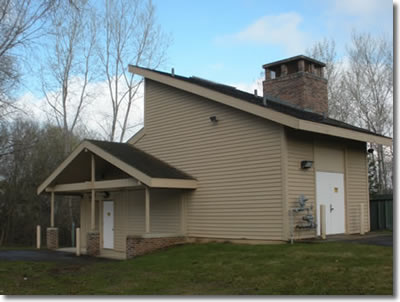 |
| The city’s well houses were designed to blend in with residential and commercial buildings. |
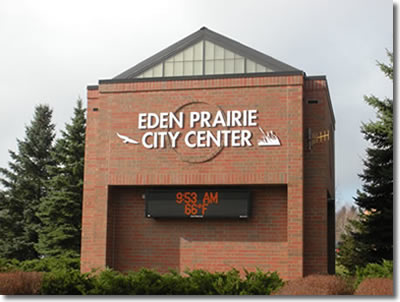 |
Of interest
Pumphouses Designed for Function as Well as Attractiveness
Eden Prairie Reservoir and Pumphouse to Replicate and Recognize History
Updated
